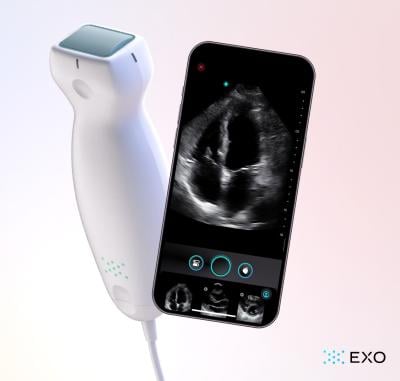Exo was founded in 2015 with the goal of building a high-quality ultrasound system that incorporated artificial intelligence and patented Piezoelectric Micromachined Ultrasonic Transducers (pMUT) technology to improve diagnostic imaging—and which could also fit entirely in the palm of a clinician’s hand.
Nearly a decade and more than $300 million in funding later, Exo has made that dream a reality. The company, whose name is pronounced “echo,” announced this week the launch of its Iris handheld ultrasound device.
Like other handheld ultrasound probes like those from GE HealthCare, Butterfly Network and more, the Iris system is designed to replace traditional cart-based ultrasound machines with a simple, slimmed-down mechanism that connects to a smartphone to display its captured images.
The device “represents a new era of ultrasound,” CEO Sandeep Akkaraju said in the company’s announcement. “It’s built to perform as easily as taking an image with a smartphone. For caregivers who’ve bemoaned out-of-touch medical technology, you’ve been heard. This device is meant for you and everyone in healthcare—it will save lives, improve patient care and lower costs.”
The Iris system is now available for purchase in the U.S. at a starting price of $3,500. Its cart-based competitors, meanwhile, can retail for anywhere between $5,000 and $200,000.

Iris’ handheld probe can capture images with a 150-degree field of view—which the company says can encompass a full liver or an entire fetus—and a depth of 30 centimeters. It can also switch between curved, linear or phased arrays, which usually require separate probes in traditional ultrasound systems.
The device is meant to be extremely easy to use, allowing clinicians to capture clear and accurate images no matter their level of imaging training. That’s helped by Exo’s SweepAI technology, which uses AI to capture scans of the highest quality possible as a clinician sweeps the probe across a patient’s body.
Exo’s ultrasound system will also ultimately include a host of other AI tools that’ll analyze the scans in real time to provide calculations and other assessments to help quickly triage potential health issues. To start, the Iris system will come equipped with an FDA-cleared bladder-focused AI solution that’s programmed to calculate bladder volume in a matter of seconds, from a sweep of the probe.
The company has also received FDA nods for AI tools that can look for signs of hip dysplasia and determine whether a thyroid nodule is malignant, and it’s awaiting agency review of two more solutions designed to estimate cardiac ejection fraction and guide clinicians through the process of scanning the lungs.
In addition to the AI tools, Iris also integrates with Exo Works, an app for both desktop and mobile access. When a mobile device equipped with the software is connected to the ultrasound probe, clinicians can use the app to access a patient’s health record, start the exam—and switch between exam types without switching probes—add in any needed notes and share the resulting images directly from the device. From there, the app allows doctors to view and annotate those images from any device.
The ultrasound system slots into a hospital’s electronic health record software to add the scans to patient records and simplify the billing process. It also works with a facility’s existing IT platform to store the collected scans—which can alternatively be saved on Exo’s own cloud server. To make the system even more accessible, according to its maker, Iris can work without an internet connection, allowing it to be used on the go and in rural settings.